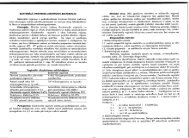PHYSICS
n - susliks.lv
n - susliks.lv
- No tags were found...
You also want an ePaper? Increase the reach of your titles
YUMPU automatically turns print PDFs into web optimized ePapers that Google loves.
there are 4 - 6 layers of iridophores that collectively comprise an<br />
area of up to 60 urn in thickness. Their presence increases the reflectance<br />
by about 65%. In insects, color change generally involves<br />
phase changes of li pids or other materials within the cuticle.<br />
Often these alterations produce a change from nearly black to a<br />
shiny metallic blue or green, depending on the ambient temperature.<br />
168<br />
UV<br />
UV-CI UV-BIUV-A<br />
100 280 315<br />
400 nm<br />
Chapter 23. PHOTOBIOLOGY<br />
Photobiology is the branch of biophysics concerned with the<br />
effect of light on living organisms.<br />
23.1. ELECTROMAGNETIC SPECTRUM<br />
The entire frequency range of electromagnetic waves is called<br />
the electromagnetic spectrum. Part of the spectrum is shown in<br />
fig. 23.1. The upper part of the top bar shows two of the most<br />
important sources of radiation (solar and thermal) and the lower<br />
part names three important bands - ultraviolet (290 - 400 nm),<br />
visible (400 - 700 nm) and near-infrared (700 - 2500 nm). The<br />
second bar shows three bands of the ultraviolet (UV-C, UV-B<br />
and UV-A) and the wave bands of the visible colors.<br />
400<br />
Visible<br />
IR<br />
700 nm<br />
3<br />
6 10 um<br />
Fig. 23.1. Scale of electromagnetic waves in ultraviolet,<br />
visible and infrared parts of spectrum<br />
r<br />
23.2. EFFECT OF ULTRAVIOLET RADIATION<br />
ON LIVING ORGANISMS<br />
23.2.1. Human and Animal Health<br />
Ultraviolet radiation (UV) is generally divided into three<br />
groups, based upon the biological effectiveness of the photons in<br />
each. The UV-C range contains the shortest wavelengths « 280<br />
nm) and the highest energy photons, which are capable of causing<br />
ionizing reactions in the upper atmosphere. Due to absorption<br />
by ozone in the stratosphere, UV-C radiation does not reach<br />
the Earth's surface. UV-B radiation (280 - 320 nm), however,<br />
does reach the biosphere in small and variable quantities. The radiation<br />
is of sufficient energy to cause direct damage to chromophoric<br />
regions of absorbing macromolecules such as nucleic acids<br />
and proteins. UV-B radiation is responsible for damage to crop<br />
plants. At longer wavelengths, UV-A radiation (320 - 400 nm)<br />
absorption is usually less strong and is dominated by molecules<br />
with conjugated double bonds, and cyclic and polycyclic molecules<br />
(e.g., isoprenoids, flavonoids, quinines, alkaloids), metal<br />
enzymes, and others. The increase in UV-B radiation entering the<br />
biosphere is associated with stratospheric ozone depletion and is<br />
likely to have a significant detrimental impact on human health.<br />
Eye diseases. UV radiation can damage the cornea and lens of<br />
the eye. Chronic exposure to UV-B is one of several factors clearly<br />
associated with the risk of cataracts. Artificial sources of UV radiation<br />
also cause corneal damage. For example, the injury from a<br />
welder's arc is known as flash burn, welder's flash or arc eye.<br />
Other sources of UV radiation injury include sun tanning beds,<br />
carbon arcs, photographic flood lamps, lightning, electric sparks,<br />
and halogen desk lamps. Prolonged exposure to UV radiation can<br />
lead to several ocular surface disorders such as pinguecula, pterygium,<br />
climatic droplet keratopathy, and even squamous metaplasia<br />
and carcinoma.<br />
Immune suppression. Some components of the immune system<br />
are present in the skin. UV exposure decreases the immune response<br />
to skin cancer, infectious agents, and other antigens.<br />
Erythema. The normal acute effects of visible and ultraviolet<br />
radiation arise by photochemical change in the epidermis due to<br />
169






